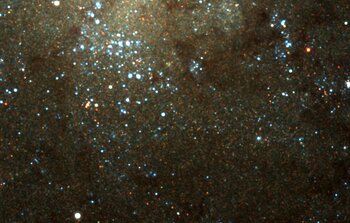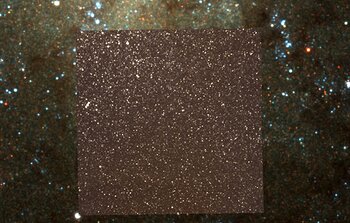Gemini's Near-Infrared Imager Images Over 120,000 Stars in the Nearby Galaxy M33
February 26, 2003

The Gemini Near-infrared Imager (NIRI) has been working reliably and delivering excellent images at wavelengths between 1 and 5 microns. In one NIRI program, very sharp images (0.35 arcsecs FWHM without adaptive optics correction) of 11 different sub-regions of the nearby spiral galaxy M33 were collected over a period of two nights in September 2002.
The infrared NIRI images probe through the intervening dust in M33 and allow us a clear view of the many evolved giant stars in this galaxy. In the inset infrared (IR) image, 22,000 individual giant stars were detected and measured. The image on the left shows what this same field looks like at visible wavelengths with a seeing of 0.75 arcsecs (FWHM). The dust seen in the optical image all but disappears in the NIRI IR image (a composite of 1.6 and 2.1 micron images).
Taking a census of the stars in other galaxies is a very important part of understanding the history and composition of this and other galaxies. From the numbers, colors, and brightness of the stars, astronomers can infer how galaxies form, how their compositions have evolved, and when their stars were born. NIRI's field of view and high IR sensitivity make it possible to extend the stellar census of M33 and other galaxies to many more and much fainter stars. When the 11 fields like the one above are considered together, a total of 120,000 stars were measured.
Among the 22,000 stars in this IR image, there are a handful of Cepheid-variable stars. Cepheids pulsate with a rate that is directly related to their intrinsic mass and luminosity. Cepheid variables are the gold nuggets in images like this one because they can be used to accurately determine the distance between us and the Cepheids. Distance measurements to far-away galaxies are very difficult to make, and finding large numbers of Cepheid variables in galaxies like M33 makes the job much easier. Over 100 Cepheids can be found among the 120,000 stars measured as part of this program, making it one of the largest compilations of Cepheids in any galaxy. Accurately measuring the Cepheid variables in M33 will allow astronomers to improve the accuracy of distances measured to galaxies as far away is 60 million light years.
NIRI was built by the University of Hawai`i Institute for Astronomy, Honolulu, HI.

